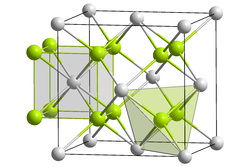Berkelium (IV) oxide
| Crystal structure | |||||||
|---|---|---|---|---|---|---|---|

|
|||||||
| __ Bk 4+ __ O 2− | |||||||
| Crystal system | |||||||
| Space group |
Fm 3 m (No. 225) |
||||||
| Lattice parameters |
a = 533 pm |
||||||
| Coordination numbers |
Bk [8], O [4] |
||||||
| General | |||||||
| Surname | Berkelium (IV) oxide | ||||||
| other names |
Berkelium dioxide |
||||||
| Ratio formula | BkO 2 | ||||||
| Brief description |
brown solid |
||||||
| External identifiers / databases | |||||||
|
|||||||
| properties | |||||||
| Molar mass | 279.07 g mol −1 | ||||||
| Physical state |
firmly |
||||||
| Hazard and safety information | |||||||
 Radioactive |
|||||||
|
|||||||
| As far as possible and customary, SI units are used. Unless otherwise noted, the data given apply to standard conditions . | |||||||
Berkelium (IV) oxide is an oxide of the element berkelium . It has the empirical formula BkO 2 . Since all isotopes of Berkelium are only artificially produced, Berkelium (IV) oxide does not have any natural occurrences. Among other things, it is implicitly created in small quantities in nuclear reactors when uranium dioxide (UO 2 ) or plutonium dioxide (PuO 2 ) are irradiated with neutrons.
presentation
Berkelium (IV) oxide is a brown solid and crystallizes in the cubic crystal system in the fluorite structure in the space group Fm 3 m (No. 225) with the coordination numbers Bk [8], O [4]. The lattice parameter is 533.4 ± 0.5 pm .
Reactions
Berkelium (III) oxide (Bk 2 O 3 ) is produced from BkO 2 by reduction with hydrogen:
safety instructions
Classifications according to the CLP regulation are not available because they only include chemical hazard and play a completely subordinate role compared to the hazards based on radioactivity . The latter also only applies if the amount of substance involved is relevant.
Individual evidence
- ^ AF Holleman , E. Wiberg , N. Wiberg : Textbook of Inorganic Chemistry . 102nd edition. Walter de Gruyter, Berlin 2007, ISBN 978-3-11-017770-1 , p. 1972.
- ↑ The hazards emanating from radioactivity do not belong to the properties to be classified according to the GHS labeling. With regard to other hazards, this substance has either not yet been classified or a reliable and citable source has not yet been found.
- ↑ Joseph Richard Peterson: The Solution Absorption Spectrum of Bk 3+ and the Crystallography of Berkelium Dioxide, Sesquioxide, Trichloride, Oxychloride, and Trifluoride , Ph.D. Thesis, October 1967, US Atomic Energy Commission Document Number UCRL-17875 (1967).
- ↑ JR Peterson, BB Cunningham: Crystal Structures and Lattice Parameters of the Compounds of Berkelium I. Berkelium Dioxide and Cubic Berkelium Sesquioxide , in: Inorg. Nucl. Chem. Lett. , 1967 , 3 (9), pp. 327-336 ( doi : 10.1016 / 0020-1650 (67) 80037-0 ).
- ↑ a b R. D. Baybarz: The Berkelium Oxide System , in: J. Inorg. Nucl. Chem. , 1968 , 30 (7), pp. 1769-1773 ( doi : 10.1016 / 0022-1902 (68) 80352-5 ).
literature
- David E. Hobart, Joseph R. Peterson: Berkelium , in: Lester R. Morss, Norman M. Edelstein, Jean Fuger (Eds.): The Chemistry of the Actinide and Transactinide Elements , Springer, Dordrecht 2006; ISBN 1-4020-3555-1 , pp. 1444-1498 ( doi : 10.1007 / 1-4020-3598-5_10 ).
